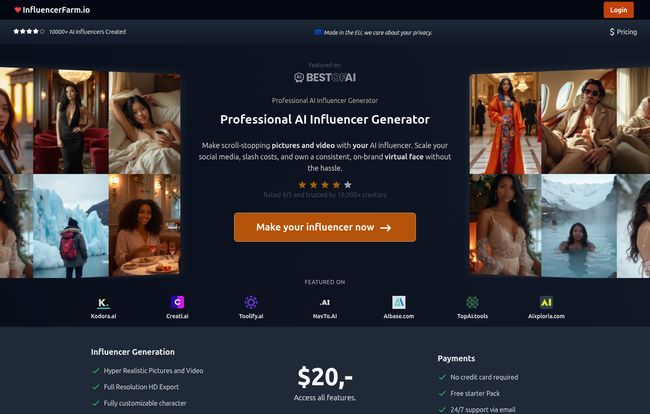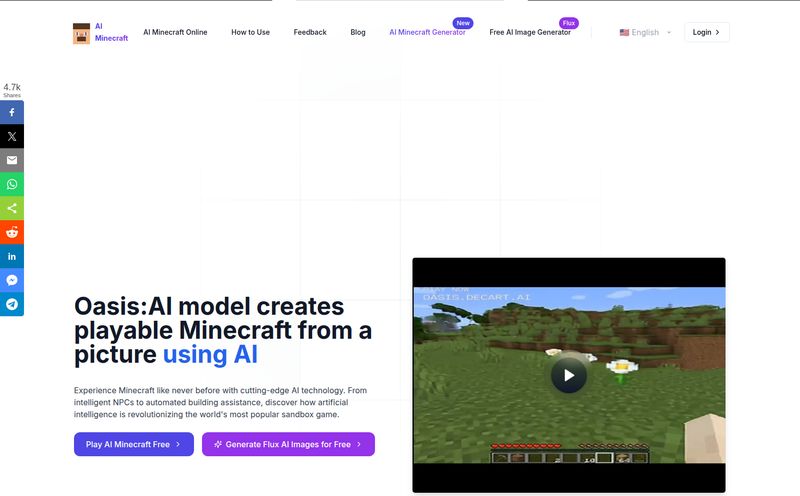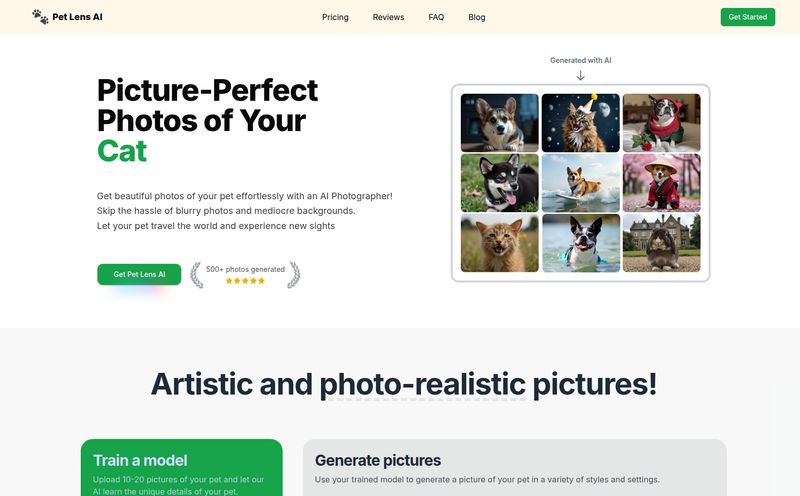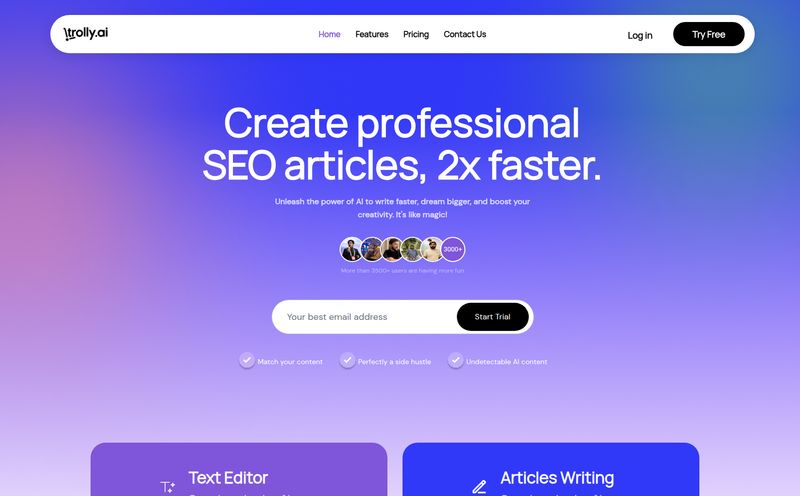Let me tell you a story. A few years back, I was managing a campaign for a new lifestyle brand. We blew a huge chunk of our budget on an influencer who, on paper, was perfect. Great engagement, perfect aesthetic. The contract was signed, the money was sent. And then... crickets. The post finally went live two weeks late, at 3 AM on a Tuesday, with a caption that had all the personality of a toaster manual. It was a nightmare. We’ve all been there, right? Pouring money and hope into a campaign only to see it fizzle out because of the human element.
So when the concept of AI influencers started gaining steam—beyond the mega-famous Lil Miquela—my ears perked up. What if you could have all the benefits of an influencer—the aesthetic, the audience connection—without the flakiness and five-figure price tags? It sounds like a marketer's dream. That’s the promise of platforms like InfluencerFarm. And being the terminally curious SEO guy that I am, I had to see if it was legit or just the next shiny object destined for the digital graveyard. I jumped in, credit card in hand, to find out.
What Exactly is InfluencerFarm? (And Why Should You Care?)
Okay, let's break it down. InfluencerFarm isn't just another AI image generator that spits out weird, six-fingered hands. It’s a dedicated platform designed to create a consistent, controllable virtual influencer. Think of it as a digital modeling agency, a photo studio, and a creative director all rolled into one tidy software package. You don’t just generate a random face; you create a persona. You give them a name, a backstory, and then you can place them in virtually any scenario you can dream up for your brand’s campaign.
Want your influencer sipping your new energy drink on a balcony in Santorini? Done. Want them showcasing your hiking gear on a mountaintop in Patagonia? No problem. The goal here is to give brands, especially smaller ones, access to high-quality, campaign-specific imagery without the logistical and financial headache of a real-world photoshoot. It's a bold idea, and frankly, a pretty compelling one.

Visit InfluencerFarm
My First Impressions: Stepping into the Virtual Photoshoot
Signing up was simple enough. The interface is clean, dark, and feels pretty modern. The first thing you do is browse their existing AI models or create your own. This part is fun. It's like creating a character in a video game. I decided to invent an influencer for a fictional, rugged, ethically-sourced coffee brand. Let's call her 'Anya.' I pictured her as an adventurous, thoughtful photographer type.
Once you have your influencer, you organize a “photoshoot.” This is where the magic (and the AI prompts) happen. You choose your model (Anya), a location (I chose a 'cozy cabin in the woods'), a style, and then you describe the scene. My prompt was something like: "Anya sitting by a large window, morning light streaming in, holding a rustic ceramic mug of coffee, looking thoughtfully at the forest outside."
A few moments later, I had a handful of options. And I have to admit, they were impressive. Not just good, but really good. The lighting was believable, the mood was perfect. One image was so spot-on it was almost spooky. The platform then gives you the option to upscale your chosen shot to 4K, making it totally usable for social media, ads, or even website banners.
The Big Question: Is This a Cost-Effective Move?
This is where things get interesting for us traffic and conversion folks. A real-life photoshoot with a model, photographer, and location rental can easily run you thousands of dollars. A single sponsored post from a mid-tier influencer can be $500 to $5,000. So, what’s the damage with InfluencerFarm?
Their pricing model seems to be a mix of subscription and pay-as-you-go credits. The homepage I saw mentioned a $20+ plan for full feature access. But when you dig in, it seems to center around credit packs. This is what I could piece together:
| Plan Name | Price | What You Get |
|---|---|---|
| Starter Plan | $8 | 10 Credits |
| Best Value Plan | $17 | 32 Credits |
| Mega Pack | $29 | 59 Credits |
Each photoshoot or video generation consumes credits. So, for less than the cost of a few lattes, you can generate a whole batch of custom marketing assets. Compared to the traditional alternative, the value proposition is… well, it’s huge. Even if you burn through a Mega Pack on a single campaign, you're likely spending less than 10% of what a comparable real-world campaign would cost. That's disruptive.
The Good, The Bad, and The Uncanny
No tool is perfect, of course. My brief romance with InfluencerFarm revealed some incredible highs and a few things that gave me pause.
The Upsides: Total Control and Consistency
The biggest win here is absolute brand control. Your AI influencer will never post an off-brand meme, get into a Twitter feud, or forget to use the right hashtag. They are a perfectly polished, 24/7 brand ambassador. You control the narrative, completely. This consistency is a godsend for brands that have a very specific image to maintain. The speed is another massive plus. You can go from an idea to a finished, high-res marketing asset in minutes. Not weeks. Minutes.
The Downsides: Authenticity and the AI Elephant in the Room
And here's the other side of the coin. Can a string of code ever be truly authentic? Some might argue no. The connection an audience feels with a real human influencer, with their real-life struggles and triumphs, is hard to replicate. You run the risk of your content feeling a bit… sterile. A bit too perfect.
Then there's the ethical consideration. I'm a firm believer that you should disclose when you're using an AI influencer. The FTC's guidelines are all about transparency, and trying to pass off an AI as a real person feels deceptive and is likely to backfire spectacularly if you're found out. It's a tool for creativity, not a tool for deception. Let's keep it that way.
Who is This Tool Actually For?
After playing around with it, I have a pretty clear idea of who would get the most out of InfluencerFarm.
- Startups and Small Businesses: This is a no-brainer. If you have a tiny marketing budget but need to look like a major player, this is your secret weapon. You can create a professional, cohesive look for your brand on a shoestring.
- Marketing Agencies: For agencies, this is a fantastic new service to offer clients. Imagine pitching a campaign that includes a custom-built virtual brand ambassador. It's innovative and sets you apart.
- Dropshippers and E-commerce Stores: Need to showcase your products in dozens of different lifestyle settings? Instead of buying expensive stock photos, you can create your own for pennies on the dollar.
Who isn't it for? Probably brands built on deep, personal human connection. A therapist's office or a life coach, for example, would likely find it jarring. It’s all about context.
A Few Final Thoughts and My Verdict
So, is InfluencerFarm the future of marketing? Maybe not the entire future, but it's definitely a significant part of it. It's not a replacement for real human stories and connections. But as a tool for generating stunning, on-brand creative at scale, it's incredibly powerful. It solves a real, expensive problem for many businesses.
My advice? Don't think of it as hiring an influencer. Think of it as commissioning art. You are the creative director, and the AI is your infinitely flexible, impossibly fast photographer and model. It's a new brush in the marketer's toolkit, and a seriously impressive one at that.
Frequently Asked Questions About InfluencerFarm
- How much does InfluencerFarm cost?
- It primarily uses a credit-based system. You can buy credit packs starting from around $8 for 10 credits, which you then use to generate photos and videos. This makes it much cheaper than traditional photoshoots.
- Are the AI influencers realistic?
- For the most part, yes. The quality is very high, and with good prompts, you can generate photorealistic images. However, like all AI, it can sometimes produce slightly 'off' results, but you can simply generate new options.
- Can I create videos with InfluencerFarm?
- Yes, the platform supports video generation. The Basic plan mentioned in their data includes up to 120 seconds of HD video, which is great for creating short-form content for platforms like TikTok or Instagram Reels.
- Do I have to tell my audience my influencer is AI?
- While the platform doesn't force you to, it's highly recommended. Transparency is key in marketing. Being upfront builds trust, while trying to deceive your audience can severely damage your brand's reputation.
- What are "credits" used for in InfluencerFarm?
- Credits are the currency of the platform. You spend them each time you generate a photo or a video. Think of it as a pay-as-you-go model for content creation.
- Is it hard to use InfluencerFarm?
- Not at all. The interface is quite intuitive. If you've ever used any other AI image generator or even just customized a character in a game, you'll feel right at home. The process is broken down into simple steps.
Conclusion
The world of AI is moving at a breakneck pace, and marketing is right in the thick of it. Tools like InfluencerFarm are no longer science fiction; they are practical, accessible, and honestly, pretty fun to use. It democratizes high-end creative, giving the little guys a chance to produce campaigns with the same polish as the big brands. While it won't replace the raw authenticity of a real human connection, it carves out a fascinating and powerful new niche. For marketers willing to experiment, the virtual frontier is wide open.
Reference and Sources
- InfluencerFarm Official Website
- Lil Miquela on Instagram - An example of a world-famous virtual influencer.
- FTC's Endorsement Guides - For information on transparency in advertising.


